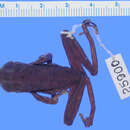Description
provided by AmphibiaWeb articles
Diagnosis and Description: This species is described by Loveridge (1945) as a moderately large tree frog, with the SVL measuring 34 – 44 mm. The head is as long as it is broad. The tympanum is moderate and about half of the orbital diameter (Loveridge 1945). Tyler and Davies (1978) describe the species as having long fingers, which are usually unwebbed, with terminal discs. Relative finger lengths in increasing order, are as follows: I, II, IV, III (Loveridge 1945). Toes are long and webbed. Coloration: The dorsal skin is dark green and brown, and usually coarse, especially on the eyelids and the head. The ventral surface is usually colored with streaks or patches of dark pigments. Nasal cavities are small and widely separated (Tyler and Davis 1978). Color in Preservation: Color in preservative is a lead color on the dorsum. A white patch is present on the upper lip beneath the eye. The venter is dusky brown or grayish (Loveridge 1945).
- Loveridge, Arthur (1945). ''New Tree Frogs of the Genera Hyla and Nyctimystes from New Guinea.'' Proceedings of the Biological Society of Washington, 58, 53-58.
- Richards, S. J. (2007). A Rapid Biodiversity Assessment of the Kaijende Highlands, Enga Province, Papua New Guinea. RAP Bulletin of Biological Assessment 45. Conservation International, Arlington, VA.
- Richards, S., Parker, F. (2004). ''Litoria becki''. In: IUCN 2011. IUCN Red List of Threatened Species. Version 2011.2. www.iucnredlist.org. Downloaded on 16 November 2011.
- Tyler, M.J. and Davies, M. (1977). ''Species-groups within the Australopapuan hylid frog genus Litoria Tschudi.'' Australian Journal of Zoology Supplementary Series, 63, 1-47.
Distribution and Habitat
provided by AmphibiaWeb articles
This species was documented in the 1970s and 1980s from Mount Wilhelm and Mount Giluwe in the central mountains of Papua New Guinea. In 2007, a rapid assessment in Papua New Guinea documented a population of L. becki in the high-montane moss forests of the Kaijende Highlands in the Enga Province, at elevation 3,200 m; this new discovery represents a large expansion of known range for the species (Richards, et al, 2007). The species lives in high elevation montane grasslands, and breeds in streams. In 2007, it was found only in and near small open-water bogs in grasslands.
Life History, Abundance, Activity, and Special Behaviors
provided by AmphibiaWeb articles
The ova are large, unpigmented, and are laid on the undersurface of stones in fast-flowing streams. The tadpoles have not been observed, but most likely have dorsoventrally flattened bodies and suctorial mouthparts (Tyler and Davies 1978).
Life History, Abundance, Activity, and Special Behaviors
provided by AmphibiaWeb articles
This species is listed as vulnerable by IUCN because it is known from fewer than 5 locations. The areas in which it has been found have very little human impact, but a potential threat is the spread of chytridiomycosis, which could affect the declines of high-altitude, torrent-dwelling tree frogs in Australia (Richards and Parker, 2004).
Beck's tree frog
provided by wikipedia EN
Beck's tree frog (Litoria becki) is a species of frog in the subfamily Pelodryadinae. It is endemic to Papua New Guinea.[2] Its natural habitats are tropical moist montane forests, grasslands and streams.[1] It was first described by the British biologist and herpetologist Arthur Loveridge in 1945 and is named in honour of the American ornithologist and explorer Rollo Beck who led the Whitney South Seas Expedition in the 1920s, collecting bird and other specimens from thousands of islands in the South Pacific.[3]
Description
Beck's tree frog is a fairly large tree frog with a snout-to-vent length of between 34 and 44 mm (1.3 and 1.7 in). The head is about as wide as it is long, with small, widely separated nostrils and tympani (eardrums) somewhat smaller than the eyes. Both fingers and toes are long with the toes being webbed while the fingers have disced tips and are unwebbed, the third finger being the longest. The skin is rather coarse, especially on the head and eyelids, but in other parts of the body it is finer. The upper parts of head and body are brown or dark green, and the underparts are streaked with dark colour.[4]
Distribution and habitat
Beck's tree frog is endemic to the mountainous regions of Papua New Guinea. It was at first only known from the two highest mountains in the country, Mount Wilhelm in the Bismarck Range and Mount Giluwe in the Southern Highlands. Specimens have been found at altitudes of over 3,000 metres (9,800 ft). In 2007, a previously unknown population was discovered at an altitude of 3,200 metres (10,500 ft) in the Kaijende Highlands in Enga Province.[1][4] The typical habitat of this frog is mountain grassland including boggy areas with pools. It breeds in rapid mountain streams, the large eggs being stuck onto the underside of stones. The tadpoles are not known.[4]
Status
Very little is known of this frog and its habits. The high-altitude sites at which it has been observed are far from human settlements and subject to little human impact. It might be vulnerable to the amphibian disease chytridiomycosis which affects some montane, torrent-dwelling frog species in Australia. The IUCN has listed it as being of "least concern".[1]
References

- license
- cc-by-sa-3.0
- copyright
- Wikipedia authors and editors
Beck's tree frog: Brief Summary
provided by wikipedia EN
Beck's tree frog (Litoria becki) is a species of frog in the subfamily Pelodryadinae. It is endemic to Papua New Guinea. Its natural habitats are tropical moist montane forests, grasslands and streams. It was first described by the British biologist and herpetologist Arthur Loveridge in 1945 and is named in honour of the American ornithologist and explorer Rollo Beck who led the Whitney South Seas Expedition in the 1920s, collecting bird and other specimens from thousands of islands in the South Pacific.
- license
- cc-by-sa-3.0
- copyright
- Wikipedia authors and editors

